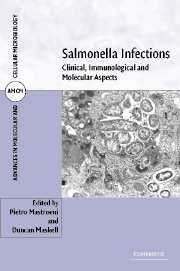Book contents
- Frontmatter
- Contents
- List of contributors
- Preface
- 1 Epidemiological and clinical aspects of human typhoid fever
- 2 Antibiotic resistance in Salmonella infections
- 3 Host-specificity of Salmonella infections in animal species
- 4 Public health aspects of Salmonella enterica in food production
- 5 The Salmonella genome: a global view
- 6 Pathogenicity islands and virulence of Salmonella enterica
- 7 In vivo identification, expression and function of Salmonella virulence genes
- 8 Mechanisms of immunity to Salmonella infections
- 9 Interactions of S. enterica with phagocytic cells
- 10 Interactions between Salmonella and dendritic cells: what happens along the way?
- 11 Immunity to Salmonella in domestic (food animal) species
- 12 Newer vaccines against typhoid fever and gastrointestinal salmonelloses
- 13 S. enterica-based antigen delivery systems
- Index
- Plate section
- References
12 - Newer vaccines against typhoid fever and gastrointestinal salmonelloses
Published online by Cambridge University Press: 04 December 2009
- Frontmatter
- Contents
- List of contributors
- Preface
- 1 Epidemiological and clinical aspects of human typhoid fever
- 2 Antibiotic resistance in Salmonella infections
- 3 Host-specificity of Salmonella infections in animal species
- 4 Public health aspects of Salmonella enterica in food production
- 5 The Salmonella genome: a global view
- 6 Pathogenicity islands and virulence of Salmonella enterica
- 7 In vivo identification, expression and function of Salmonella virulence genes
- 8 Mechanisms of immunity to Salmonella infections
- 9 Interactions of S. enterica with phagocytic cells
- 10 Interactions between Salmonella and dendritic cells: what happens along the way?
- 11 Immunity to Salmonella in domestic (food animal) species
- 12 Newer vaccines against typhoid fever and gastrointestinal salmonelloses
- 13 S. enterica-based antigen delivery systems
- Index
- Plate section
- References
Summary
INTRODUCTION
Typhoid and paratyphoid fever result from infection with Salmonella enterica serovars Typhi and Paratyphi respectively. Humans are the only reservoir of these infections that are spread by the fecal-oral route. The control and near elimination of this disease in Western countries has been achieved largely because of improved sanitation, surveillance, contact tracing and successful therapy. In locations where this infrastructure does not exist, vaccines can be used as one measure to control the incidence of typhoid fever (Tarr et al., 1999) and possibly even to contribute to the eventual eradication of the disease.
Non-typhoidal S. enterica infections are a major public health problem world-wide and reduction of the incidence of these diseases presents quite different challenges to reducing the incidence of typhoid fever. In fact, these diseases have several animal reservoirs and, in humans, a large number of different S. enterica serovars cause gastroenteritis probably making vaccines very difficult to realize and/or use commercially.
This chapter will outline the current development of vaccines that address disease caused by S. enterica, with an emphasis on typhoid fever.
TYPHOID VACCINES
A short history of typhoid vaccines
Typhoid fever vaccine development began shortly after the so-called “Golden Age” of microbiology, at the end of the 19th Century. The initial discovery of the typhoid bacillus was made by Eberth in 1880 and it was first isolated from stools by Pfeiffer in 1896 (Warren and Hornick, 1979).
- Type
- Chapter
- Information
- Salmonella InfectionsClinical, Immunological and Molecular Aspects, pp. 323 - 336Publisher: Cambridge University PressPrint publication year: 2006



